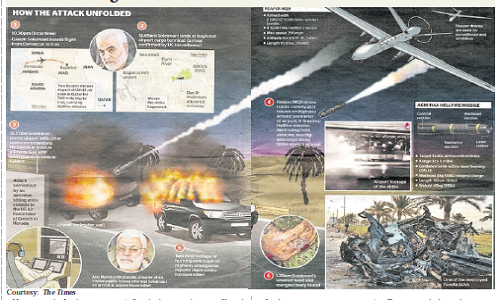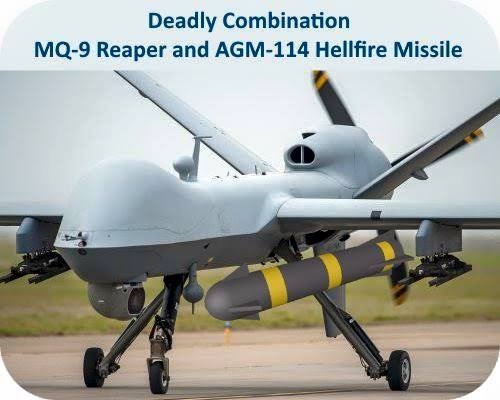
Unknown to the world, an operator sitting at the console in the U.S Air Force Base at Creech in Nevada 7,000 miles away pushed the button of the drone that nailed Iran top General Qassem Soleimani.
It is no longer news that Iran’s most powerful and revered military leader, General Qassem Soleimani, whom Washington accused of plotting imminent attacks against United States (U.S.) forces in the region, was killed in Baghdad, Iraq and buried in his hometown of Kerman in Iran. But fresh information has revealed how the button of the drone, which killed him was pushed 7,000 miles away by an operator sitting at the console in the U.S Air Force Base at Creech in Nevada.
Unmasking the mystical figure
From consolidating Iranian influence in Iraq to waging war against the “Islamic State” in Syria, Soleimani was an instrumental figure for Iranian aspirations in the region.
In Iran and among its Shia allies across the Middle East, Soleimani, 62, enjoyed near mythical status. He was described in Time Magazine’s I00 most influential people as “James Bond, Erwin Rommel and Lady Gaga rolled into one.”

His rise to power came via the Islamic Revolutionary Guard Corps (I RGC), which was set up after the 1979 revolution to protect the Islamic Republic and enforce its ideological aims. The IRGC cemented its hold after the Iran-Iraq War, ending up with vast control over the country’s economy and resources.
In the 1990s, Soleimani was given command of ‘the Quds Force, an elite unit that undertakes missions outside Iran’s borders and which had already established Hezbollah as a client militia in Lebanon. The force’s role is like few others anywhere in the world; equivalent in American terms to a combination of the CIA and Special Forces.
It was in that role that Soleimani became the chief architect of Iran’s regional strategy, creating the arc of influence that Iran terms its “Axis of Resistance” – and others the “Shia crescent” – extending through Iraq, Syria and Lebanon.
Soleimani remained a shadowy figure in that role for years. It was only in October that he revealed in a television interview that he had been in Lebanon in 2006 helping to direct the conflict between Hezbollah and Israel.
After 20 years as Iran’s master fixer across the Middle East’s trouble spots, the late head of Iran’s Quds Force might have thought he was invincible. Maybe he had put trust in President Donald Trump’s insistence that he had no desire for war with Iran and wanted to withdraw from the region altogether.
According to reports, the general certainly knew that U.S. and Israeli leaders had for years plotted his assassination and then baulked at the possible consequences.
His last moments
But, the last moves in the great game played by Soleimani, before he was killed showed brazen confidence. When he flew from Damascus to Baghdad late on Thursday night, from one of the key capitals Tehran believes it has in its pocket to another, he did not use a secret military or militia airbase. He flew in his personal and Iranian-regime jet to Baghdad’s main international airport.
The General knew that the airport is not only a daily route for local, foreign and western civilians and soldiers in and out of the country, but it is also adjacent to a military base shared by the Iraqi counterterror service and U.S. forces.
He was travelling with senior aides from the Iranian Revolutionary Guard – Brigadier-General Hussein Jafari Nia, Colonel Shahroud Mozafari Nia, Major Hadi Taromi and a captain, Vahid Zamanian.
He was met by Iran’s most senior operative within the Iraqi security and paramilitary forces, Jamal Jaafar Ibrahimi, better known as Abu Mahdi al-Muhandis, the man who after the U.S.-UK invasion of Iraq in 2003, set up the country’s answer to Lebanon’s Shia militia Hezbollah -Iraq’s Kataeb Hezbollah. The militia was accused by the Pentagon of being behind recent rocket attacks on U.S.-occupied bases in Iraq and five of its compounds were hit in retaliation by American F15 jets on Sunday.
Muhandis defected to Iran from the regime of Saddam Hussein in 1979 and was recruited as an agent in the ensuing war between the countries by the Revolutionary Guard.
Alongside Muhandis to greet Soleimani was Mohammad Ridha, a senior figure in the Popular Mobilisation Units (PMU), the official Iraqi government-recognised umbrella group for Iraq’s militias. Muhandis’ formal position was deputy head of the PMU, answerable directly to the Iraqi prime minister. AdeI Abdul-Mahdi.
The seven men, according to reports, piled into a Toyota SUV and a Hyundai minivan and set off out of the airport by the main road.
The drone attack
Unknown to the Iranian team, America’s formidable surveillance capabilities, masterminded from the National Security Agency in Maryland and helped by CIA operation in Baghdad, had Soleimani on their radar. Two MQ9 Reaper drones – sent from al-Udeid military and airbase in Qatar – were in place. The back-up drone was not needed. Just two missiles were used by operators at the U.S. Air Force base at Creech in Nevada, one for each of the two vehicles. The strike had been approved, the report indicated, at the same time that President Trump authorised Sunday’s attack on Kataeb Hezbollah.
People were at the scene immediately, with phone cameras. The images that quickly circulated on social media were graphic. In one, the general’s vehicle was still blazing. In another, a bloodied arm stretched out, its curled hand bearing a recognisable ring.
Mixed reactions over the assassination
The reaction following the killing was immediate. Crowds gathered in Soleimani’s home town of Kerman and Mashhad, one of the regime’s bedrocks of support.
Iraq was also in an uproar. The government found it hard to believe that an ally could assassinate Muhandis, officially a senior government official, on Iraqi soil. “The assassination of an Iraqi military commander holding an official position is an aggression against Iraq, the state, the movement and the people,” the Iraqi Prime Minister said.
“Carrying out liquidation operations against Iraqi leadership figures or from a brotherly country on Iraqi soil is a flagrant violation of Iraqi sovereignty, a blatant attack on the dignity of the country and a dangerous escalation that ignites a devastating war in Iraq, the region and the world,” he added.
Other Iraqis felt differently, as did opponents of Iran’s influence across the Middle East. Footage captured protesters in Baghdad and southern Iraq dancing in the street – Soleimani was said to have ordered the crackdown on recent demonstrations that led to hundreds being shot dead. In Syria, rebel groups that have been gradually crushed in their fight against President Assad by Soleimani and Iran’s Russian allies handed sweets to children. In Lebanon and elsewhere, relatives of people killed in Iran’s assassination programmes also celebrated
The U.S. among the first countries to order its citizens to leave Iraq. France, the Netherlands and others followed.
Iran’s retaliatory attack
Iran fired several missiles at two Iraqi bases housing U.S. troops on Wednesday local time in retaliation for the American strike that killed the top Iranian general last week.
There was a belief among the U.S. and European government officials that Iran deliberately missed areas populated by Americans.
These officials floated the notion that Iran could have directed their missiles to hit areas that are populated by Americans, but intentionally did not.
Iraq did receive a warning that the strike was coming and was able to take “necessary precautions,” according to a statement from Iraq’s Prime Minister Adil Abdul Mahdi. A U.S. defence official said that Iraq, in turn, gave warning to the United States.
Iraq’s joint military command said there were no casualties among Iraqi military forces.
Iran targeted the al-Asad airbase, which houses U.S. troops, and American and coalition forces in Erbil, according to Jonathan Hoffman, a Pentagon spokesperson. Trump had visited al-Asad in December 2018.
In a televised speech to Iran yesterday, Supreme Leader Ayatollah Ali Khamenei addressed the missile attacks and said Iran had given the U.S. “a slap in the face last night.”
The U.S. president, who was impeached last month and faces an election this year, at the weekend threatened to target 52 Iranian sites if Iran retaliated for Soleimani’s killing.
Trump signals de-escalation of tensions
Trump, who is facing the gravest test of his presidency, signalled a de-escalation of tensions with Iran on Wednesday in the wake of Tehran’s retaliatory attacks against Iraqi bases housing U.S. troops.
“Iran appears to be standing down, which is a good thing for all parties concerned and a very good thing for the world,” Trump said, striking a sombre tone during his White House statement.
Trump said an early warning system worked well and no American or Iraqi lives were lost.
The President also outlined new sanctions on Iran and reiterated his vow that “Iran will never be allowed to have a nuclear weapon.”
“The United States will immediately impose additional punishing economic sanctions on the Iranian regime,” Trump said during an address to the nation from the White House, noting his administration is continuing to review other options to respond to the Iranian missile strike on Tuesday.
“These powerful sanctions will remain until Iran changes its behaviour,” he added. “In recent months alone, Iran has seized ships in international waters, fired an unprovoked strike on Saudi Arabia and shot down two American drones.”
Though Trump appeared to indicate a move toward lower tensions, he seemed to keep his options open when describing American military readiness.
“Our missiles are big, powerful, accurate, lethal and fast,” he said, a warning tucked into a speech that otherwise indicated an easing of strain.
“The fact that we have this great military and equipment, however, does not mean we have to use it,” Trump said. “We do not want to use it. American strength, both military and economic, is the best deterrent.”
Kindly contact us @ Naijalivetv@gmail.com
Call or Whatsapp: 07035262029, 07016666694, 08129340000










